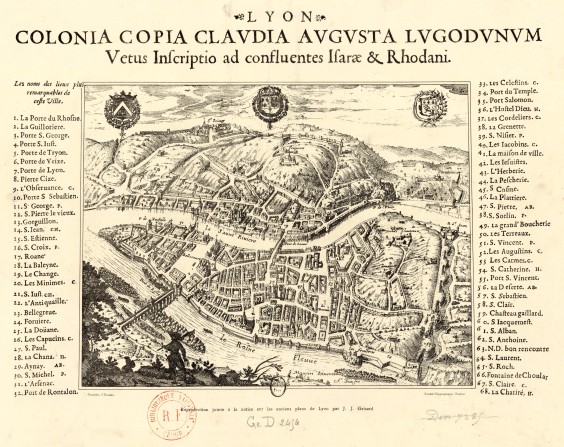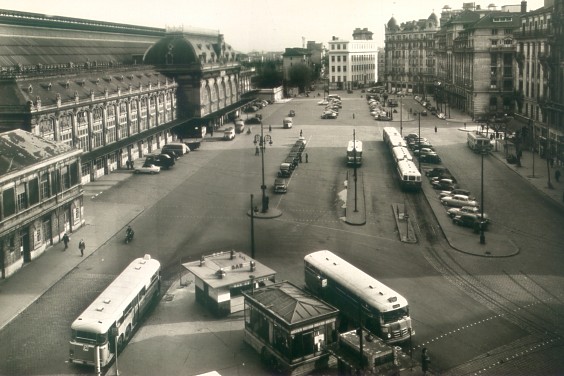A History of Lyon
Known formerly as Colonia Copia Claudia Augusta Lugdunum, Lyon was once part of an important Roman province. Founded by Lucius Muntius Plancus in the year 43 BC, Lyon served as the capital of Gaul, today’s modern France. Shortly after its founding, Lyon became one of the most important cities in Northwestern Europe. Due to its strategic position in relation to the northern Roman territories, Lyon quickly became the center of operations and communication. Its pre-existing network of roads leading in and out of the city’s center made it possible for Lyon to grow in wealth and power. With an increase of money and resources, urban development started and the Romans began to build. They constructed aqueducts, amphitheatres, forums, temples and the basilica, the site of which is located at the top of what is now Fourvière. Government was established which was divided between magistrates and the senate. The establishment of laws, taxes and their very own mint for currency enabled Lyon to officially integrate into the Roman Empire. As Lyon became an organized urban center, it quickly attracted communities of traders and craftsman. The population of Lyon soon reached about 70,000 people. This Roman capital had become a vibrant cosmopolitan city and one of the greatest cities in the entire region. It was known as the Imperial City. Its political influence was felt throughout the empire and was center stage for many major events in antiquity.

Romans to Renaissance
Following the collapse of the Roman Empire, Lyon saw the establishment of many communities and kingdoms. As land repeatedly changed hands and Lyon came under the control of various leaders, it continued to survive as an influential and politically strategic location. In 1312, Philip the Fair annexed the city of Lyon to the Kingdom of France. Between the years 1461 – 1483, during the reign of Louis XI, Lyon once again became an important economic center drawing merchants from across Europe. Trade expanded into spices and silk and with the influx of Florentine immigrants, Lyon soon became a dynamic financial center for banking. In 1472, the first printing and publishing center is established in Lyon becoming one of the best in Europe behind those in Paris and Venice. From Lyon amazing works are produced in many languages including Hebrew, Latin, Greek, Italian, Spanish and French. Years later, Lyon enjoys a boost in prosperity and becomes the source of many brilliant artists and architects. The plans for the expansion of Lyon are later drawn up by famous city planners such Soufflot, Perrache, Morand and DeCotte. Napoleon Bonaparte imposes upon the European courts the use of silk from Lyon, also known as Lyonnais Silk. This decision results in the creation of workshops, stores and a booming industry which brought the number of looms produced from 6,000 to 60,000 between the years 1800 and 1848. With the success of the worldwide silk trade, Lyon began establishing banking institutions and soon turned to investment in land in Southeast Asia, Algeria and Madagascar.

A Revolution into Modern Times
1789 saw the arrival of the French Revolution. Expansion slowed but under Napoleon’s Empire, development continued. Lyon was turned into an industrial city and urban development was re-vitalized. Silk production continued strong into the 20th century and played a central role in Lyon’s economy. By the end of the 19th century, Lyon had more than 300 silk factories, over 200,000 workers and over 300 traders. Lyon’s silk trade was flourishing, exporting to England, North America and as far as India and China. During World War II, Lyon became the center of the French Resistance. After the war modernity sparked the construction of Europe and due to the development of the transportation system, Lyon began to create hotels and tourist facilities as well as cultural and business establishments such as the Part-Dieu business quarter which was made in 1960. Beginning in the 1980’s, Lyon’s infrastructure began to improve. City plans and projects were starting everywhere while historic landmarks and centers remained preserved. As it was in Roman times, the city of Lyon is again a successful metropolis, home to financial, cultural and artistic institutions that celebrate history and pave the way for the future.
The city
Introduction to Lyon city
Back
Culture
Culture, music, theatre and shows, food, sports
More
Business
The economy of the capital city, business centers
More
Maps & plans
Maps of Rhone-Alpes region, plan of the city and public transports
More